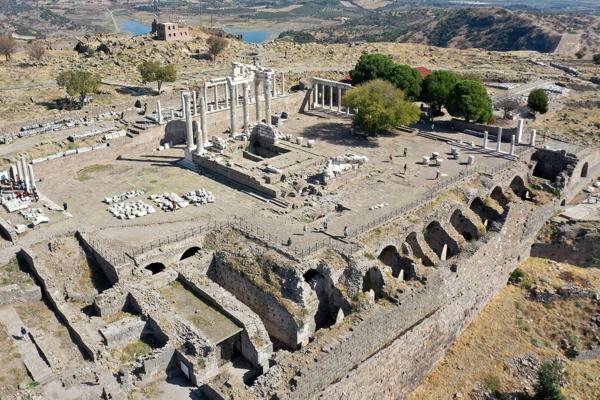Goddess figure in Pergamon reveals high culture
İZMİR


A 4,500-year-old marble goddess figure has been discovered during the surface surveys conducted in the Bakırçay Plain, located within the borders of the ancient city of Pergamon in the Bergama district of İzmir.
The ancient city of Pergamon, which is listed as a Multi-layered Cultural Landscape Site on the UNESCO World Heritage List, is home to important historical artifacts such as Asklepion, where the first psychotherapy method in the world was practiced, and the Red Basilica, one of the seven churches mentioned in the Bible.
The ancient city, bearing traces from the Hellenistic, Roman, Eastern Roman and Ottoman periods, is also home to the largest library established in Asia and the first parchment production in history took place there. Excavations in Pergamon are being carried out by a team from the German Archaeological Institute and Turkish experts.
In this year's surface surveys in the region, a 4.5-centimeter-tall marble, dated to the Bronze Age and considered part of a prehistoric belief system of its time, was encountered.
Similar to those in Troy
The head of the excavation and Director of the German Archaeological Institute, Professor Felix Pirson said that modern archaeology conducts research not only in city centers but also in the surrounding areas and regions of influence.
Pirson, noting that they use maps, satellite photos and geophysical studies during surface surveys, stated that they are also trying to learn about the life surrounding the ancient cities.
Stating that surface surveys in the Bakırçay Plain are continuing, Pirson noted: “The approximately 4.5-centimeter marble idol [goddess figurine] we found on a mound was the most important find of this year. It is roughly 4,500 years old. The small marble figure represents a human. It is not very detailed but resembles a bit of modern artwork. We believe this idol belongs to a Bronze Age cult. Maybe a goddess, perhaps the founder of that region. We don't know exactly, but we know it was very important to the people of that time."
"The idol we found is similar to those in the ancient city of Troy. This is why this first find is very important to us because this idol showed us how high the culture around this region was. Generally, we don’t know much about the prehistory of Western Anatolia. We know Troy well, but we had very little information about the entire Bakırçay Plain. Such a find became very important for this region. This idol shows that this region was not just a poor agricultural area but a place with a high culture,” he added.
Pirson emphasized that they had very little knowledge about prehistoric Bergama and noted that similar finds had not emerged, particularly from the Early Bronze Age.
Associate Professor Güler Ateş, a faculty member of the Archaeology Department at Manisa Celal Bayar University and deputy director of the Pergamon excavations, stated that the idol shows that Bergama and its surroundings were part of a certain belief geography.
Noting that a similar figure was found in Troy, Ateş said: “One of the typical idols found in Western Anatolia. Its importance for us is that such an idol had not been found in Bergama and its surroundings until today. Therefore, it is very significant.”
